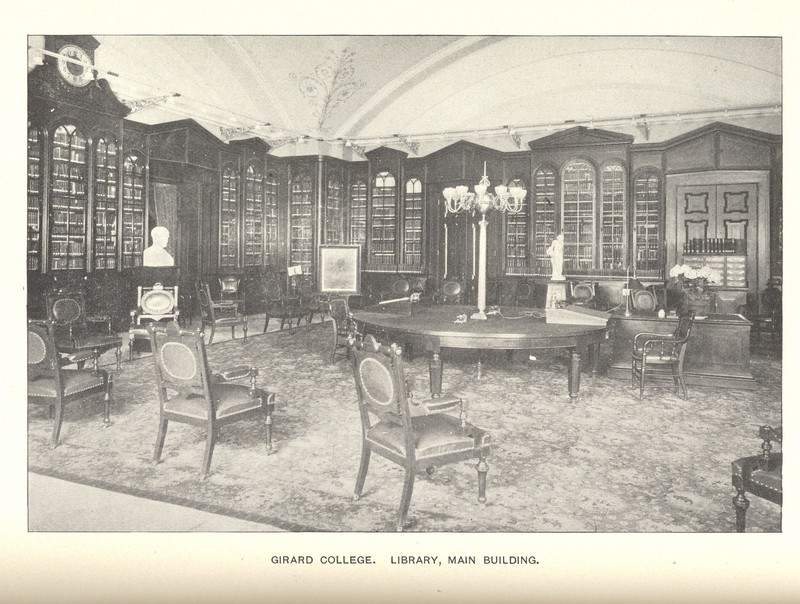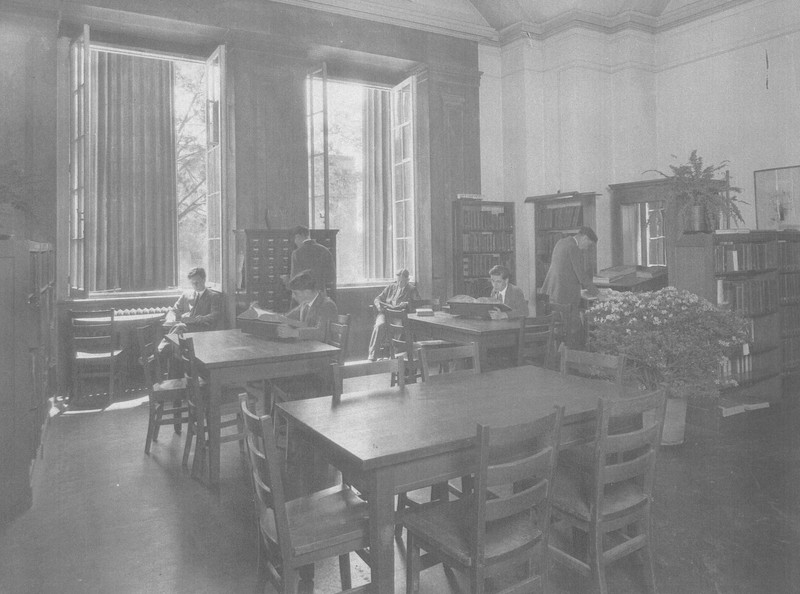Library and Learning
Introduction
Text-to-speech Audio
When Girard College was first established in 1848, Founder’s Hall and the four surrounding dormitories were the only school buildings on the 43-acre campus. Founder’s Hall served as the original classroom building; it also originally housed the chapel and the library, which was located in this room. The wooden bookcases date from 1855; they originally featured a wood finish but were painted in the 20th century and most recently repainted in 20023 as part of a Founder's hall revlitalization project.
Images
The library in 1893. Note the bookcases, which remain today, although the upper cornices were removed when the murals were added.
.jpg)
The library in 1898.

A room in the library in Founder's Hall in the 1920s. This space, in the Northeast Room, was briefly used as an extension of the library.

Backstory and Context
Text-to-speech Audio
“On Founder’s Day, I go to the library upon arrival and give a prayer of thanks for Stephen Girard. It was the library that opened my eyes, my heart, and my imagination to the world outside. My interest in travel became a challenge to see the places I had read and dreamt about in the Girard College library.” (Roy Hoch, GC June 1947
When Girard College was first established in 1848, Founder’s Hall served as the original classroom building; it also originally housed the chapel and the library, which was located in this room. As the College grew, new buildings were constructed and separate chapel and library buildings were added in 1878 and 1933, respectively. When the library moved to its own building, many older library books that were no longer needed were left behind and remain in this room, under the "Banker" and "Mariner" murals. The books on the shelves under "Benefactor" belong to Founder’s Hall historical collections, which are otherwise housed and displayed on the 2nd floor.
The library supported Girard College's rigorous academic program, which like the campus, has changed and developed over the years. Stephen Girard’s will aimed to adequately prepare students for success after graduation, and it initially stipulated both strong academic instruction and vocational preparation. In 1884 the "mechanical school" was built on campus and all students followed a dual curriculum. This lasted until 1989, when the school ended the vocational curriculum and transitioned solely to a focus on college-prep and planning for post-secondary education/training, with the same goal of preparing students for life after Girard.
In recent years, Girard has updated the mathematics and ELA (English and language arts) curricula, partnering with educational programs to establish and strengthen educational concepts for elementary and middle school students. Girard College has also implemented social impact curriculum to educate students on an array of social issues. One such high school class included a partnership with neighboring Eastern State Penitentiary to discuss the intricacies of criminal justice and the mass incarceration system. “This is my favorite class because we get to talk about what’s wrong and how can we make it right." said one high school student. "We talk about the real truth. I talk about this class with such enthusiasm and I feel this fire in me that burns with curiosity.”
Sources
Sand, Richard. Laurent, Elizabeth. Girard College—a Living History. New York, NY. Oakley Publishing Inc., 2009.
Steel & Garnet. Winter 2019. Girard College Historical Collection.
Girard College Historical Collections
Girard College Historical Collections
Girard College Historical Collections
